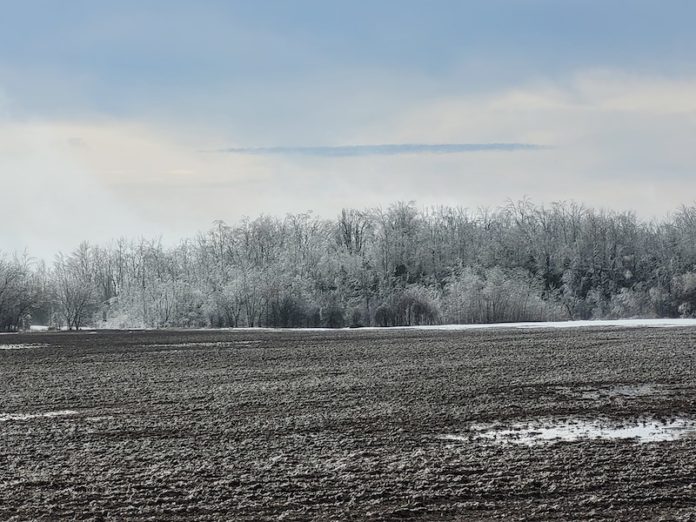Last week, we witnessed what could possibly be described as the worst ice storm since 1998. That is not meant to suggest that the April 5 storm was as bad as the infamous Ice Storm of 1998, but it’s tough to think of any storms since then that have packed the same punch as last week’s storm.
Power was knocked out for hundreds of thousands of people in Ontario, some for many days. The Hydro One outage map showed a sea of dozens of outages across Eastern Ontario, even several days after the storm. When zoomed out, the outage map almost resembled a scatterplot. When zoomed in, huge outage areas became visible. Some people – myself included – only lost power days after the storm, which is evidence of the complexity of the damage done to the electricity transmission system. It would appear that in restoring hydro for some customers, it had to be temporarily knocked out for others. An early message posted by Hydro One celebrated 370,000 customers being reconnected within a couple of days after the storm. Considering the many still without power in the days that followed, and the fact that not all Eastern Ontario customers are served by Hydro One, I suspect the actual number of people that lost power from the storm was far higher.
For those who were safely nestled indoors and didn’t look outside, or those who were away on vacation during the storm, allow me to describe it. This was essentially a “thunderstorm that froze”. In my experience, thunderstorms in the summer come and go. You can hear the storm coming, it puts on a show, and then it crawls away. But for much of the day on April 5 – the early morning straight through to the late afternoon – lightning and thunder provided a steady reminder of the mayhem outside, even for those not looking out the window.
The rain from the storm was heavy. One reader from Bishops Mills measured 67mm of rain – about 2.5 inches. However, only about 10mm of it stuck around as ice secretion, as opposed to the 50mm this reader measured during the Ice Storm of 1998. Warmer temperatures certainly prevented this storm from turning into a much more serious disaster.
School buses were unsurprisingly cancelled for students in the area on April 5, but they were cancelled again on April 6 due to continued hazardous roads conditions, probably due as much to fallen branches as it was to slippery roads. Some schools also had to be closed completely on April 6 due to a loss of power. Two consecutive school bus cancellation days in April is certainly something that we haven’t seen in a while.
Speaking of fallen branches and trees, declaring that they were “everywhere” in the days following the storm is not an exaggeration. One would have been hard pressed to drive a kilometre anywhere in the Municipality without seeing at least one heavy tree that had been taken down by the weight of ice secretion. It’s likely that we will bear witness to some of these fallen trees for several more weeks, since some property owners are better equipped for yard cleanup than others. Falling trees invariably take power lines down with them, of course, which is where most people felt the greatest impact from the storm. Power outages were so widespread that crews from Hydro Toronto and other utility companies drove down to lend a hand. Their help will not be forgotten.
Utility companies from different areas coming together in a time of need is just the tip of the iceberg when it comes to the kindness and generosity that this storm brought out in so many people. Power outages and torrential rains don’t mix. Countless residents’ basements flooded or were at risk of flooding. The number of locals offering to lend a spare sump pump or a spare generator to their neighbour was truly amazing. This is so much more than knocking on a neighbour’s door and asking to borrow a cup of sugar. These are expensive, finnicky pieces of equipment being lent to strangers in many cases, for no other reason than the propagation of human kindness. Maybe its because neighbours in North Grenville are never really “strangers”.
The kindness did not stop with offers to lend generators and pumps. Residents who had power or backup power were offering the use of their homes as a place to warm up, take a shower, and cook a meal. The Municipality also opened up the Municipal Centre for this purpose in the days after the storm, showing once again that we take care of our own.
Yet another acknowledgement is needed for the fire department and the OPP, who responded quickly to calls of trees blocking roads, and emergencies involving downed power lines so that these areas could be blocked off pending repair. It would seem that in a time of tragedy, everyone came together like a well oiled machine, some fulfilling their duties honourably, and others providing help that they were in no way duty-bound to provide. Hydro workers have already been mentioned, but they deserve another shout out – thank you. Their job is dangerous on a normal day, but the hard work and dedication that went into restoring power for hundreds of thousands of customers – much of it happening during a gruelling storm, I might add – will not be forgotten.
What have we learned from the “Ice Storm of 2023”? Dare I say… nothing? By this I mean that the storm simply showed us what we already know – the people of North Grenville take care of each other. The small community feel of our beloved Municipality is here to stay, and is not something we should ever take for granted. In times of need, we selflessly make sure that everyone has the necessities and comforts of life. Move aside, cup of sugar. North Grenville means business.

